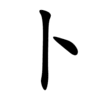卜
| ||||||||
Translingual
| Stroke order | |||
|---|---|---|---|
 | |||
Han character
卜 (radical 25, 卜+0, 2 strokes, cangjie input 卜 (Y), four-corner 23000, composition ⿰丨丶)
- Kangxi radical #25, ⼘.
Derived characters
- Index:Chinese radical/卜
References
- KangXi: page 157, character 25
- Dai Kanwa Jiten: character 2774
- Dae Jaweon: page 361, character 15
- Hanyu Da Zidian: volume 1, page 91, character 11
- Unihan data for U+535C
Chinese
Glyph origin
| Historical forms of the character 卜 | |||||
|---|---|---|---|---|---|
| Shang | Western Zhou | Warring States | Shuowen Jiezi (compiled in Han) | Liushutong (compiled in Ming) | |
| Oracle bone script | Bronze inscriptions | Chu Slip and silk script | Qin slip script | Small seal script | Transcribed ancient scripts |
 |
 |
 |
 |
 |
 |
| Characters in the same phonetic series (卜) (Zhengzhang, 2003) | |
|---|---|
| Old Chinese | |
| 仆 | *pʰoːɡs, *pʰus, *pʰoɡs, *bɯːɡ, *pʰoːɡ |
| 赴 | *pʰoɡs |
| 訃 | *pʰoɡs |
| 朴 | *pʰroːɡ |
| 圤 | *pʰroːɡ |
| 卜 | *poːɡ |
| 鳪 | *poːɡ |
| 扑 | *pʰoːɡ |
| 攴 | *pʰoːɡ, *pʰroːɡ |
Perhaps a pictogram (象形) of a crack in an oracle bone, used for divination in ancient China.
Officially adopted as the simplified form of 蔔 in the Chinese Character Simplification Scheme (《漢字簡化方案》) in 1956.
Pronunciation
Compounds
Etymology 2
| For pronunciation and definitions of 卜 – see 蔔. (This character, 卜, is the simplified form of 蔔.) |
Notes:
|
Etymology 3
| For pronunciation and definitions of 卜 – see 欲 (“wish; desire; to wish; to desire; to want; etc.”). (This character, 卜, is a variant form of 欲.) |
References
- “Entry #64”, in 臺灣閩南語常用詞辭典 [Dictionary of Frequently-Used Taiwan Minnan] (in Chinese and Min Nan), Ministry of Education, R.O.C., 2011.
Japanese
Noun
卜 (hiragana うらない, rōmaji uranai)
- Alternative form of 占い
- (archaic) fortune-telling
- (archaic) fortune-telling
Korean
Hanja
卜 • (bok) (hangeul 복, revised bok, McCune–Reischauer pok, Yale pok)
- This term needs a translation to English. Please help out and add a translation, then remove the text
{{rfdef}}.
Vietnamese
Han character
卜
References
- Nôm Foundation
- Vietnamese Dictionaries: Viet Fun, Viet Dictionary
This article is issued from Wiktionary. The text is licensed under Creative Commons - Attribution - Sharealike. Additional terms may apply for the media files.